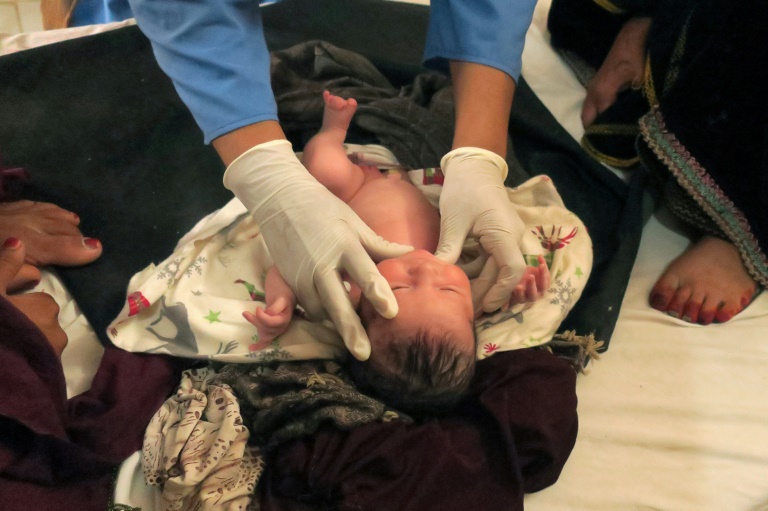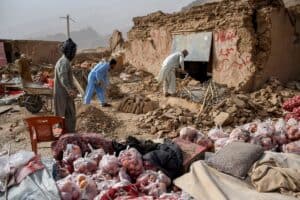Women often arrive in extremis at the maternity hospital in southeastern Afghanistan, one of the most active in the world, with more than 60 babies born daily.

The early hours of the morning are the most feverish for the Doctors Without Borders maternity hospital — affectionately known by the NGO as “the baby factory” — just a stone’s throw from Pakistan’s tribal areas, in Khost province.
The Taliban are active in the region and roads are often dangerous after dark, so when 25-year-old Asmad Fahri felt her contractions begin at night she knew she would have to wait until daybreak to begin the three-hour journey to the hospital.
Finally she is resting, her infant tightly swaddled and asleep between her knees.
On average, new mothers are kept in the ward for six hours, but she has asked to leave after just three, to ensure she reaches home before darkness falls again.

Sometimes the mothers have to travel for days, in pain and bleeding, over unpaved insecure roads in carts or by whatever mode of transportation they can find | © AFP | ANNE CHAON
Sometimes the mothers have to travel for days, in pain and bleeding, over unpaved, insecure roads in carts or by whatever mode of transportation they can find.
In an opposite wing, the delivery tables continuously welcome newcomers.
Most only have time to lift the long layers of clothing hiding their bodies and wedge their coloured veils between their teeth, too rushed even to change into Doctors Without Borders’ (MSF) standard red pyjamas.
The Khost Maternity Hospital (KMH) opened at the end of 2012 in a medical desert in the conflict-riven country, with one of the highest infant and maternal mortality rates in the world.
It was an overnight success, with nearly 12,000 deliveries in its first full year in 2013.
By 2017, that figure had nearly doubled to 23,000.
This year, the hospital is on track to deliver 24,000 babies, says Dr Rasha Khoury, a Palestinian gynaecologist who is a medical officer at the site.

The Khost Maternity Hospital (KMH) opened at the end of 2012 in a medical desert in the conflict-riven country | © AFP | ANNE CHAON
If so, that puts it within crying distance of the busiest maternity wards in the US, where the Northside Hospital in Atlanta delivered 27,000 babies in 2016, the highest number in the country that year.
“Here we are saving lives for free,” smiles Safia Khan, 24, the assistant manager of the midwifery team.
Behind her, a young mother of twins searches her skirts and hands her a folded banknote. It is a traditional gesture of gratitude after delivery, at times required in some hospitals but politely declined here. “It’s forbidden,” insists Khan.
More deadly than war
The UN and the World Bank put maternal mortality at around 396 deaths per 100,000 live births in Afghanistan.
But the figure is disputed, with experts pointing out it is an improbable fall from the 1,600 per 100,000 recorded in 2002.
Such a decline would mean Afghanistan would have reached its Millennium Development Goal set by the UN some five years early, a study published in the medical journal the Lancet noted in 2017.

MSF doctors say the charity facilitates around 40% of the births in Khost, which has an estimated 1.5 million inhabitants | © AFP | JUSTINE GERARDY
The authors of that study say more credible figures released by the Afghan government in partnership with USAID suggest maternal mortality could still be as high as 1,291 per 100,000 — meaning that giving birth is around five times more deadly for Afghan women than the conflict itself.
If so, it is a staggering figure 17 years after the fall of the Taliban regime, despite billions of dollars in international aid, in a country with one of the youngest, fastest-growing populations in the world.
Dr Khoury says that MSF facilitates around 40% of the births in Khost, which has an estimated 1.5 million inhabitants.
But to make a real dent in the mortality rates in the face of these challenges they would need “three hospitals like MSF” she says.
Pashtunwali
On top of war, poverty, and a galloping population, the medical staff face a further obstacle: the Pashtunwali, the patriarchal social code of honour that dictates life in the conservative Pashtun tribal region where Khost lies.
Under the Pashtunwali, the genders must be segregated, and a woman must never show her face to a stranger.
As such, medical staff at the hospital are exclusively female, with the exception of some anaesthetists and the director of the neonatology department.
Even so, a little persuasion has at times been necessary, says Salamat Khan Mandozai, a respected local figure who deals with security for the hospital and has also acted as a community liaison.
“In this rural environment, some women still prefer to give birth at home,” he notes.
Going to hospital embarrasses them, agrees Safia Khan — birth is a private matter.

Medical staff at the hospital are exclusively female, with the exception of some anaesthetists and the director of the neonatology department | © AFP | JUSTINE GERARDY
Dr Khoury says the hospital is aware that many women are not coming to them, but adds that the families who do come do so “without hesitation”.
For many, she adds, obstacles are not about culture, but finances — namely, paying for transportation — or safety and security, especially at night.
Women must also wait until a man of the family is available to accompany them, she says.
But once inside the hospital, power returns to the mothers-in-law who escort the patients until they reach the doors of the delivery room.
“We are really reaching people at the margin of the society in Afghanistan,” says Dr Khoury.
“It’s a success story.”
– AFP






